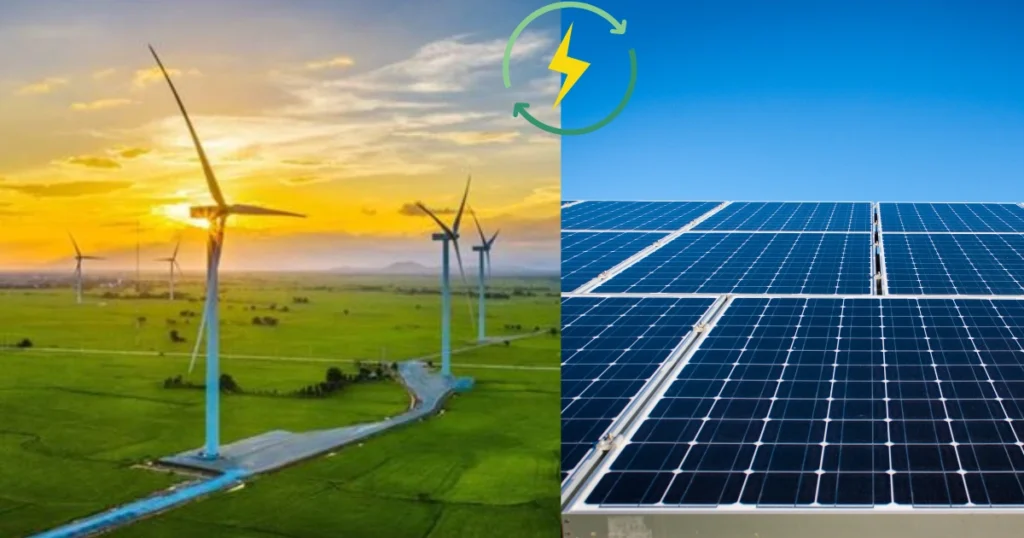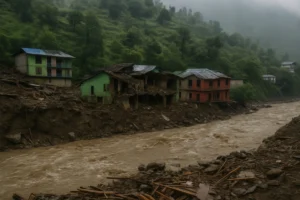India Clean Energy Surge: Bold Moves Toward a Greener Future

Wind turbines and solar arrays are powering India’s transition to clean energy, marking its rise as the world’s third-fastest growing power generator.
By Somya Prabhat | newslyy.com
In the last five years, India has quietly climbed into the ranks of global clean-energy superpowers—trailing only the U.S. and China in power generation growth. But this isn’t just a local energy story. It’s a structural shift that’s challenging decades of fossil-fuel dependency and reshaping the economics of development. The India clean energy surge is not only transforming the subcontinent’s power grid—it’s beginning to shift the balance of global influence.What makes the India clean energy surge unique is that it comes not from surplus, but from scarcity. It’s not a luxury—it’s a necessity. The momentum behind India clean energy is accelerating like never before. Across the country, solar parks in Rajasthan and wind farms in Tamil Nadu are redefining the nation’s power mix.
With strong government backing, massive foreign investments, and bold net-zero goals, India clean energy is quickly becoming more than an environmental push.
It’s now a strategic pillar for economic growth, energy security, and global leadership.
What’s fueling this dramatic leap? And what does it mean for the world?
Table of Contents
The Numbers Behind the Surge
According to data from the International Energy Agency (IEA), India now ranks third globally in electricity generation growth, backed by an overwhelming shift toward renewables. A staggering 83% of capital expenditure in India’s power sector is now flowing into clean energy—solar photovoltaics (PV), wind, hydro, and storage—marking a dramatic departure from its coal-dominated past.
In 2023 alone, India added over 18 GW of solar capacity, placing it among the top three solar markets worldwide, right behind China and the United States. Much of this expansion is being driven by government-backed initiatives like the Production Linked Incentive (PLI) scheme and public-private partnerships through the Solar Energy Corporation of India (SECI).
And while the numbers are impressive, the momentum behind them is what’s turning heads globally.
From Fossil Fuels to Frontier Energy
India’s energy transition is unlike anything the West has seen. Rather than incrementally retiring fossil fuels, India is leapfrogging them—scaling clean infrastructure while still being one of the few countries with rising energy demand. That distinction is critical.
Unlike Europe, where energy consumption is plateauing or declining, India’s demand for power is expected to double by 2040. But rather than doubling coal plants, India is electrifying its future through solar parks, decentralized rooftop solutions, and green hydrogen pilots.
As Prime Minister Narendra Modi declared at COP26 in Glasgow, India has set a target of 500 GW of non-fossil fuel capacity by 2030—a goal that was initially met with skepticism. Now, many analysts believe India could reach that number ahead of schedule.The India clean energy surge is happening in parallel with industrial expansion, making it a rare case of decarbonization alongside GDP growth.
(Read our related editorial on Why BRICS is Building a Parallel Green Economy).
Financing the Future: Who’s Backing India’s Green Boom?
What makes this India clean energy surge even more notable is the sheer amount of capital flowing in from international financial institutions. According to the World Bank, India received over $10 billion in green energy financing in 2023 alone. This includes direct funding from multilateral banks, as well as climate-linked sovereign bonds and private equity in energy startups.
The Green Climate Fund, backed by the UN, is also funneling capital into India’s grid modernization and battery storage programs, helping to stabilize variable renewable sources. Meanwhile, domestic energy giants like Tata Power, Adani Green, and ReNew Energy Global have each pledged multi-billion-dollar expansions into solar and wind.
These aren’t small experiments—they’re infrastructure-scale commitments.
(External DoFollow Source: Times of India – India 3rd globally in power generation growth)
Solar as Strategy: India’s Geopolitical Play
Beyond economics, India’s clean-energy play is becoming a strategic lever in global geopolitics. With China still dominating solar manufacturing, India has launched its own solar module PLI scheme to boost domestic production and reduce dependence on imports. The country is also positioning itself as a key supplier of green hydrogen, particularly for Europe and Southeast Asia.
Initiatives like the International Solar Alliance (ISA), co-founded by India, reflect this growing ambition. India is no longer just a recipient of climate aid—it’s a rule-maker in the emerging green order.
Consider this: while Germany is paying billions to stabilize its gas supply and the U.S. is embroiled in internal battles over clean-energy subsidies, India is quietly exporting solar expertise to Africa and forging trilateral clean-energy pacts with France and Japan.
Challenges Remain: Storage, Land, and the Last Mile
Despite the optimism, India’s clean-energy roadmap isn’t without hurdles. Energy storage remains a critical gap—solar energy is abundant but still inconsistent. While pilot battery projects are underway, widespread grid-level storage is years from maturity.
Land acquisition is another flashpoint. Large-scale solar and wind farms require significant acreage, often in rural or ecologically sensitive zones. Balancing development with displacement remains politically sensitive.
Then there’s the “last mile” challenge: integrating millions of low-income households into the clean grid, especially in rural Bihar, Odisha, and the Northeast, where energy access is still patchy. The transition needs to be not just green—but just.
Why the World Should Be Watching
India’s clean-energy journey is about more than emissions targets or gigawatt bragging rights. It’s a proof of concept: that a fast-growing, densely populated developing country can align economic growth with environmental responsibility—without pausing for Western-style wealth accumulation first.
In a world where climate promises often remain paper-deep, India is delivering results at scale. And it’s doing so while maintaining GDP growth above 6.5%, a feat few other clean-energy leaders can claim.
As energy analysts at BloombergNEF have noted, India could become a template for other Global South nations navigating the energy transition without sacrificing development. If it works, the India clean energy surge could end up being not just a domestic transformation—but a global tipping point.
Conclusion: The Quiet Revolution Lighting Up the Future
India isn’t leading the clean-energy conversation with flashy headlines or climate grandstanding. But on the ground, in the form of solar panels glinting across Rajasthan’s deserts, wind turbines in Gujarat’s hills, and rooftop panels from Mumbai to Mizoram, a quiet revolution is underway.
The India clean energy surge is not only greening the grid—it’s redefining what growth looks like in the 21st century. And if this pace continues, India might not just meet its climate goals. It may set the bar for how the next billion people will be powered—cleanly, affordably, and equitably.With every solar park and every billion-dollar PLI investment, the India clean energy surge signals a future where power is clean, local, and scalable.







2 thoughts on “India Clean Energy Surge: Bold Moves Toward a Greener Future”